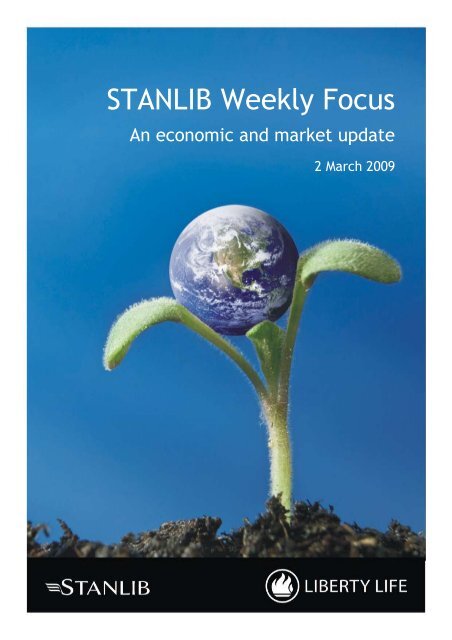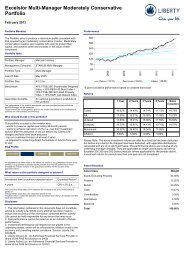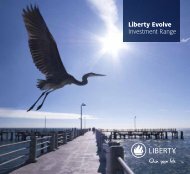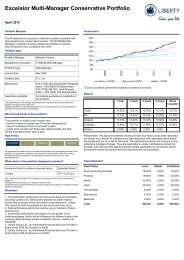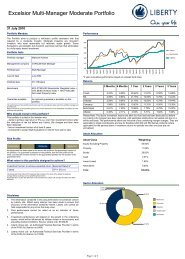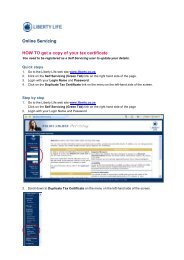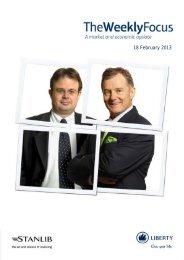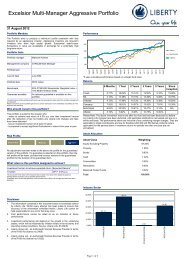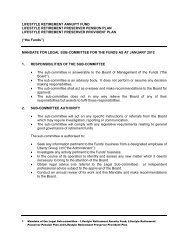You also want an ePaper? Increase the reach of your titles
YUMPU automatically turns print PDFs into web optimized ePapers that Google loves.
<strong>STANLIB</strong> <strong>Weekly</strong> <strong>Focus</strong>An economic and market update2 March 2009
ContentsNewsflash ................................................................................................ 3Market returns (courtesy of Deutsche Bank)................................................................. 3Bank credit analyst (BCA) remains cautious and underweight global equities .......................... 5More on offshore equities......................................................................................... 6Economic Update ....................................................................................... 8Global ................................................................................................................ 8<strong>STANLIB</strong> Economic Crisis Monitor - no change to the table this week .................................. 8USA.................................................................................................................... 9US Q4 GDP performance revised substantially lower to -6.2%q/q ...................................... 9South Africa ........................................................................................................ 10SA GDP declined slightly more than expected in Q4 2008, dropping 1.8%q/q ....................... 10SA CPI inflation higher than expected in January at 8.1%y/y ........................................... 11SA credit demand is slowing sharply across most areas of finance .................................... 12SA recorded a shock trade deficit in January of R17.4bn ................................................ 13Rates .................................................................................................... 15Standard Bank Money Market Fund ............................................................................ 15<strong>STANLIB</strong> Cash Plus Fund .......................................................................................... 15<strong>STANLIB</strong> Dividend Income Fund ................................................................................. 152
NewsflashWhile the rand has lost 23% against the dollar over the past 12 months, it hasamazingly lost only 6% against the euro and has in fact gained 8.2% against thepound.Market returns (courtesy of Deutsche Bank)Equity Market (FTSE/JSE) - Other IndicesFebruary 3 6 12 Year-to-Code Name 2009 months months months dateHeadline IndicesJ200 Top 40 -10.4% -14.1% -34.1% -39.7% -14.6%J201 Mid Cap -6.4% -0.6% -15.9% -20.1% -8.2%J202 Small Cap -8.3% -7.9% -23.1% -33.3% -9.5%J203 ALL SHARE INDEX -9.9% -12.4% -32.0% -37.6% -13.7%TradableJ210 Resource 20 -8.8% -11.4% -39.6% -47.7% -11.2%J211 Industrial 25 -11.0% -11.9% -25.2% -25.0% -15.2%J212 Financial 15 -12.2% -21.4% -30.3% -36.2% -19.5%J213 Financial & Industrial 30 -11.6% -15.9% -28.0% -29.8% -17.1%Secondary MarketJ230 Development Capital -2.7% -14.0% -33.9% -57.8% -23.4%J231 Venture Capital -14.6% -65.5% -67.6% -83.3% -64.2%J232 Alt X -18.3% -30.2% -54.0% -58.1% -25.2%Specialist IndicesJ250 Financial & Industrial -10.6% -13.1% -25.6% -27.8% -15.5%J257 All Share Industrials -10.6% -10.4% -24.0% -24.2% -14.7%J258 All Share Resources -8.9% -11.5% -39.6% -47.7% -11.3%J253 SA Listed Property -2.8% 0.8% 0.8% -1.0% -3.9%J255 Property Unit Trusts -2.9% 3.6% 1.8% -4.5% -3.1%J256 Property Loan Stocks -2.7% -0.1% 0.6% 0.3% -4.1%With regard to the performance numbers above, it is interesting to see that despite theextremely depressed world economy (and therefore depressed demand for resources), theResource 20 Index (-11.2% year-to-date) has outperformed the Financial & Industrial 30 Index (-17.1%). Of course, Resources underperformed hugely in the six months to end December - andin the twelve months to end February - so perhaps they had already had the stuffing knockedout of them. However, because of perceived higher risk, <strong>STANLIB</strong> is underweight resources.Also of interest is that Small Caps (-9.5%) and Mid Caps (-8.2%) have outperformed the Top 40 (-14.6%) in the first two months of 2009, although ALT X (-25.2%) has more than made up forthat!3
Disappointingly, after the big decline, the All Share Index is up only 1.8% per year over the pastthree years, although the five year return is a reasonably healthy 14.4%. Financials are down7.4% a year over 3 years and even the Property unit trust return is a paltry 3.6% per year.February 3 6 12 Year-to-Name 2009 months months months dateAll Bond -2.86% 1.4% 8.2% 12.5% -5.2%After an excellent 2008, the All Bond Index has given back a bit so far in 2008 (-5.2% as above),with the longer-term bonds (12 years-plus to maturity) losing the most (-10.3%). Inflationlinkedbonds have lost 0.9% so far in 2009.Bonds have declined in value as the bond yields have risen in response to the much highersupply of bonds due from the SA Government (and others like Eskom) in 2009, partly because ofthe economic slow-down, which means less tax revenue.February 3 6 12 Year-to-CodeEconomicGroupSector 2009 months months months dateUSDZAR Rand to the US dollar 1.1% -0.2% -23.6 -23.0 -5.4%While the rand has lost 23% against the dollar over the past 12 months (see above), it hasamazingly lost only 6% against the euro and has in fact gained 8.2% against the pound, justillustrating the huge move in the dollar in the past year relative to the euro and pound (a bigchange from the previous six or so years).Year-to-date the All Share Index is down 18.4% in dollar terms (-13.7% in rand terms), only veryslightly worse than the MSCI World Index‟s -18% (see below). By comparison, the MSCI EmergingMarkets Index is down just 11.7% (see below) because of Brazil (-0.2%).Interestingly, copper has had the best 2009 to-date (up 16.8% in dollars), whereas platinum andsilver are both up 15.4% and gold is up 7%.4
International Equity Indices (US$ Total return)Country/ February 3 6 12 Year-to-Region Name 2009 months months months dateWorld MSCI World Free -10.2% -15.3% -43.4% -46.8% -18.0%EM MSCI Emerging markets -5.6% -4.8% -47.2% -56.0% -11.7%Pacific MSCI Pacific -10.4% -10.9% -37.8% -44.1% -17.1%Europe Dow Jones Euro Stoxx 50 -12.38% -18.4% -48.9% -54.0% -26.0%Emerging MarketsBrazil Bovespa -5.0% 0.5% -52.9% -57.3% -0.2%China MSCI China -3.2% -1.9% -36.9% -49.8% -11.2%India MSCI India -10.4% -3.7% -49.8% -62.8% -12.2%Russia MSCI Russia -0.9% -18.8% -67.3% -74.4% -11.9%South Africa MSCI South Africa -6.5% -7.2% -41.8% -44.8% -18.3%South Korea KOSPI 200 -18.2% -5.3% -47.1% -60.0% -21.7%Turkey MSCI Turkey -10.97% -14.5% -56.9% -60.5% -19.5%Developed MarketsFrance Cac 40 -9.9% -17.0% -47.4% -50.9% -23.2%Germany Dax 30 -12.2% -17.6% -48.4% -52.3% -27.0%Hong Kong Hang Seng -3.5% -7.8% -38.5% -45.3% -11.0%Japan Nikkei 225 (not TR) -13.1% -13.4% -35.8% -40.8% -20.9%UK FTSE 100 -8.0% -16.2% -45.8% -51.1% -13.6%Dow JonesUSAIndustrial-11.2% -19.2% -37.7% -40.6% -18.9%USA Nasdaq 100 -5.1% -7.0% -39.8% -35.9% -9.0%USA S&P 500 -10.65% -17.3% -41.8% -43.3% -18.2%So far in 2009, the JSE All Share Index (-18.4%) is outperforming France (-23.2%), Germany (-27%) and Japan (-20.9%) and is only slightly behind the US (-18.2%).Bank credit analyst (BCA) remains cautious and underweight globalequitiesAlthough BCA, the well regarded Canadian research house, views the US government‟s bankbailout program as a positive step that “should help to break the vicious circle of adeteriorating economy and bank deleveraging”, they remain concerned that US corporateearnings will remain under downward pressure over the next year because of continuedweakness in the economy.Therefore they think it is still too early to buy offshore bank shares and the broader equitymarket.Also, although supply cuts and demand from China have perhaps put a floor under somecommodity prices, “these positive factors on their own are not enough to spark a renewed bullmarket in commodities”.5
Fears were widespread that bank shares were going to zero because of widespreadnationalization. Instead, the Capital Assistance Program (CAP) is designed so that the nation‟slargest banks will not only survive but will remain in private hands as well.Following a stress test, the 19 largest US banks that are deemed to be undercapitalized in a“worst case” scenario will receive a government capital injection in the form of convertiblepreferred shares that pay 9%. These preferred shares will be converted into ordinary shareseither at the bank‟s request or at the end of seven years. Banks have the option for the first sixmonths to raise private capital and buy back the preferred shares without penalty if they can.So the plan effectively rules out any near-term nationalization and reinforces that all of themajor US financial institutions have the full backing of the government.The hope is that the banks can grow their way back to health before the seven year limit.The only problem is that there may not be sufficient political backing for the plan sincetaxpayers bear lots of risk for limited potential returns. Also, the stress tests for the 19 bankswill only be completed by the end of April, still a way off.Nevertheless, a lesson from past bank crises around the world is that a stabilization of thebanking system is a pre-requisite for an economic recovery. So somehow it has to be done.The authorities must ensure access to credit for healthy borrowers, especially in the smallbusiness sector, where bank credit is their lifeline.More on offshore equitiesIt is notable that financial companies in the S&P 500 Index were 22% of the index a few yearsago. They are now 10% of the index. AIG has lost 99% of its value and is down to $0.42 and isexpected to report a loss of around $60bn today. Citigroup is down 94% in the past year.Equity investors around the world are going through a very tough time, to be sure. Forexample, on a total return basis, the S&P 500 Index has underperformed long-term treasurybonds for the past 5, 10 and 25 year periods. Of course, part of this reason is that the treasurybonds currently remain in their amazing 28 year-old bull market, where yields have fallen from12% in 1982 to under 3% (bond prices rise when yields decline).From 1949 to the end of 2000, the S&P 500 Index provided a total return of 13.1% per year,while treasury bonds could grind out only 5.8%, so it is really the past 18 months that haveseverely damaged the equity market returns. Then again, this occurs in all bad bear markets.How about valuations (price-to-earnings or PE ratios)? Robert Shiller from Yale University hasdone much to popularize the so-called “cyclical” PE ratio. This compares current share pricesto average earnings during the past 10 years, rather than to the most recent year of earnings,thereby evening out the bumps in earnings multiples caused by the profit cycle.6
Apparently this has proven to be a good market timing vehicle. The highs and lows of thiscyclical PE have overlapped almost perfectly with highs and lows for the stock market.Currently the cyclical PE is 13.2, well below the average since 1870 of 16.3. Also, it is at itslowest since 1986 (23 years).But…it has in the past dropped as low as 6.6 (1982 recession). Perhaps one factor in favour oftoday‟s 13.2 reading is that both inflation and interest rates are extremely low now and PEratios usually have an inverse relationship to inflation and interest rates, ie the lower inflation,the higher the fair value PE ratio.See chart of the JSE All Share Index (below), showing the market once again approaching thelows of this bear market, last seen in November (17,814).It is crucial that the All Share Index manages to hold these lows; otherwise it could fall towardsthe 14,000 level, according to technical analysts.Source: I- Net BridgePaul Hansen(Group Director, Retail Investing)7
Economic UpdateOur global crisis monitor remained unchanged during last week, as the global environment battledto find any good new. The US Q4 GDP figure was revised down sharply from - 3.8%q/q annualized,to -6.2%q/q, which is the biggest decline since 1982! More bad news is expected at the end of thisweek, as February job losses in the US are expected to equate to 650 000, pushing the world largesteconomy further and further into recession.Back home our Q4 GDP figure declined slightly more than expected, dropping to - 1.8%q/q.Consumer inflation came out higher than expected during January; however Producer inflation at9.2%y/y was below December‟s reading and below market consensus. Money supply and privatesector credit extension continued to slow, with credit growth expected to ease significantly furtherduring most of 2009 justifying further interest rate cuts. We recorded a shock trade deficit of R17.4billion during January, reflecting a 25% plunge in exports.This week we will see February vehicle sales along with the PMI (manufacturing) data. Bothindicators are expected to confirm an economy under pressure. (The Q4 2008 Labour Force Surveyrecorded a surprise 189 000 increase in employment). We are also expecting a further petrol pricehike of roughly 45c/l this week; however diesel users will enjoy a cut of approximately 38cl, due tothe slowing demand for international rail and ocean transport.Global<strong>STANLIB</strong> Economic Crisis Monitor - no change to the table this weekThe aim of the crisis monitor is to try and measure whether or not the unprecedented policyresponse to the current global economic crisis is working. This applies especially to the US, as itremains the key financial and global economy. We have selected 15 key indicators that reflectthree key areas of the US economy, namely Housing Activity, Credit Markets, and the RealEconomy.Unfortunately, still only 3 out of the 15 indicators selected are showing a meaningfulimprovement. The positive indicators are still the US mortgage rates, which are at historicallylow levels; the TED spread which remains below 100bps; and commodity prices, which shouldhelp to keep inflation low. All the other indicators remain a concern, especially the highlevel of inventories, the risk/volatility indicators, and the weekly jobless claims.On balance, the financial/credit/housing environment has not changed that much over the pastweek. The key US stimulus packages have all been introduced and will be implemented over8
the coming months. In the meantime, anxiety over the viability of global banks and job lossesremains extremely high.USAUS Q4 GDP performance revised substantially lower to -6.2%q/qIn Q4 2008 US GDP fell by a very significant and revised 6.2%q/q, annualised. This compareswith an initial estimate of 3.8%q/q, published a few weeks ago. This is the worst economicperformance in the US for more than 26 years.The downward revision was fairly broad-based across most sectors of the economy includinginventories, net exports, and non-durable consumer spending.The decrease in real GDP in the fourth quarter primarily reflected negative contributions fromexports, most areas of personal consumption expenditure, equipment and software, andresidential fixed investment.This was partly offset by positive contributions from consumer spending on services, privateinventory investment (almost definitely an unintentional build-up of inventories) and federalgovernment spending. Imports, which are a subtraction in the calculation of GDP, decreased. Infact the decrease in imports added an amazing 2.99 percentage points to quarterly change inGDP.Consumer spending came under significant pressure, declining by 4.3%q/q in Q4 2008. Thiswas mostly due to a decline in spending on durables goods (e.g. motor cars) and spending onnon-durables (e.g. food and clothing).Fixed investment spending also remains under enormous pressure. There was a furthersignificant decline in investment spending on equipment and software as well as residentialproperty. The overall decline in residential property activity has actually been evident since atleast the middle of 2006.In 2008 real GDP increased by 1.1% in 2008 compared with an increase of 2.0 percent in2007, and a long-term average of around 3.0%.The US National Bureau of Economic Research (NBER) recently concluded that the US economyentered a recession at the start of 2008. While some analysts question this conclusion, there isno doubt that the US economy has been gripped by a severe downturn since at least July 2008,and is now experiencing a very severe recession.While all components of the economy are very weak, the area that stands out is consumerspending given that it represents more than 70% of the US economy. A number of factors arecombining to undermine consumer activity in the US. These include extremely weak confidencelevels, rising unemployment, and nominal personal income growth that is close to zero. Huge9
negative wealth effects (due to declining house and stock market values) are adding to thedownward pressure.Overall, we forecast US GDP to decline by almost 2.0% in 2009, with risk to the downside.South AfricaSA GDP declined slightly more than expected in Q4 2008, dropping 1.8%q/qIn Q4 2008, SA GDP declined by a significant 1.8%q/q, annualised (seasonally adjusted),down from +0.2%q/q in Q3 2008. SA‟s Q4 2008 growth rate was slightly below marketexpectations for a decrease 1.5%q/q (Bloomberg). There was another wide range of forecastsfrom a high of 0.0%q/q to a low of - 3.6%q/q (<strong>STANLIB</strong> -2.0%q/q).The decline in the Q4 2008 GDP estimate was mostly due to another massive decline inmanufacturing output. Manufacturing (which comprises 16.0% of GDP) output fell by 21.8%q/q(annualised), subtracting a dramatic 3.5% from the quarterly performance. Overallmanufacturing sector is in recession and under enormous pressure. This reflects a combinationof slowing exports, a very weak motor industry, excess inventories and a slowdown in generaldomestic economic activity, including the building industry.Other sectors of the economy are also under pressure including mining (due to lowercommodity prices and reduced export demand), and retail (due to weak consumer confidenceand slumping disposable income growth). The rate of growth in construction activity (whichrepresents 3.8% of the economy) has slowed a little to 10.0%q/q down from 15.0%q/q in Q32008; but the sector still made a healthy 0.6% contribution to overall economic performance.The residential building sector in under pressure, while construction activity associated withinfrastructural activity is holding up fairly well.Similarly, the finance sector grew by a relatively firm 3.0%q.q in Q4 2008, adding 0.6% togrowth; but is expected to show clearer signs of slowing in 2009.The economy has clearly become more and more reliant on the tertiary sector (service sectors)for growth, both in terms of consistency as well as vibrancy. In contrast the primary sectors (inthe form of agriculture and mining) have essentially stagnated for a number of years.It is therefore no surprise that the tertiary sector now accounts for almost 70% of alleconomic activity in South Africa, while the primary sector comprises a relatively modest7.7%, with the secondary sector (e.g. manufacturing and construction) making up theremaining 20%.The outlook for the next few quarter‟s points to ongoing weakness in the SA economy with thecurrent slowdown expected to broaden across most sectors of the economy, including retail,finance, transport and parts of the building and construction sector.10
Furthermore, there is obviously a strong relationship between the SA leading economicindicator and SA GDP performance. The SA leading indicator has been pointing to a meaningfulslowdown in domestic economic activity for some time and continues to suggest furtherweakness in the quarters ahead.For 2008 as a whole, SA GDP grew by 3.1%, down from the 5.1% in 2007.For 2009 we forecast GDP to slump to only 0.7%y/y, with most key sectors of the economyexpected to be either in recession or on the brink of recession.SA CPI inflation higher than expected in January at 8.1%y/yIn January 2009, headline CPI (Consumer Price Index) inflation rose by a disappointing 0.4%m/min January. The market was looking for a decrease of 0.3%m/m. On an annual basis CPI inflationfell to 8.1%y/y from 9.5%y/y in December 2008. The market was expecting a decline to 7.5%y/y(Stanlib 7.9%y/y).The January CPI data is based on the new weights introduced by Stats SA in 2008. (The CPIindex is now based on 2008 =100). This is the 21st consecutive month that CPIX inflation hasbeen above the target range of 3% to 6%.There are three main reasons for the higher than expected increases in inflation duringJanuary:1. Food prices. Food inflation rose by a shock 2.0%m/m, pushing the annual rate up to 16.1%.Most categories of food prices went higher including vegetables, fruit and meat. This isextremely unfortunate given that agricultural prices are actually declining on an annualbasis and were last recorded at -5.7%. Clearly the food value chain is using the decliningagricultural prices to re-build profit margins. Hopefully, in a relatively short period of timethe consumer will start to see the benefit. Food prices added 0.3 percentage points to themonthly increase in CPI.2. The weaker exchange rate. In 2008 the Rand/Dollar exchange rate weakened by around28%. Most of the decline occurred in the second half of the year, and is now reflecting insomewhat higher imported consumer inflation. This is especially true for items such asappliances and household equipment as well as for car parts. While the Rand has beenextremely volatile in the past couple of months, it has not weakened that significantly inthe past 5 months considering that in October 2008 the Rand/Dollar rate averaged R9.77.Hopefully this relative movement coupled with increased global deflation could help tomoderate imported consumer goods prices over the coming months.3. Financial service charges. During January financial service fees rose by a substantial3.7%m/m and by 17.1%y/y. According to Stats SA this mostly represents increases in various11
ank charges. In total, the increase in financial service fees (including insurance fees)added 0.2 percentage points to the monthly increase in inflation.These increases were, to some extent, offset by a further the decline in vehicle running costs,specifically the petrol price (which has a weight of 3.93% in the basket). During January thepetrol price fell by a very welcome R1.30c/l. Petrol inflation has now fallen to -20.3%y/y.Unfortunately the petrol price rose by 61c/l in February and looks set to rise by around 45c/l inMarch. This will clearly add some upward pressure on inflation over the coming months.Stats SA is now also providing a useful breakdown of consumer inflation according to key subsets.For example, CPI excluding food and fuel is 7.8%y/y, which is clearly still on the high side.In contrast CPI for administered prices is only 1.4%y/y.With the introduction of the new weights and compositional changes within the basket, thetargeted measure of inflation has changed from CPIX to CPI. In fact CPIX, as we knew it, nolongerexists. This is mainly because the measure of mortgage interest rates has been replacedby „Owner‟s equivalent rent‟, which has a weight of 12.21% in the new basket.Looking forward, it is very clear that CPI inflation peaked last year and should continue to falloffover the coming months. This disinflation effect should be helped by the relatively highbase that was established for many categories of consumer inflation in 2008 as well as thesignificant slump in domestic and international economic activity.However, in order for SA inflation to move convincingly back inside the target range there nowhas to be a significant moderation in food inflation, which carries a reduced weight of 14.27%On balance we expect CPI inflation to still move back into the target range during Q2 2008.This combined with the weakness in the economy and slowing credit demand should allow theReserve Bank to continue to cut interest rates.SA credit demand is slowing sharply across most areas of financeIn January 2009, SA growth in broad money supply (M3) was recorded at 12.9%y/y, down froma revised 13.6%y/y in December. The market was forecasting M3 growth at 13.6%y/y. Thelower than expected reading included a reduction in net other assets and liabilities, whileclaims on the private sector rose by R12.1bn. The overall trend in money supply growth isvery clearly to the downside, which is expected to continue in the months ahead as theeconomy slows further.Private sector credit rose by 0.6%m/m in January 2009, or R12.12bn. Interestingly R9.9bn ofthe monthly increase was in the category „other loans and advances‟ which reflects mainlycorporate credit.12
On an annual basis, the rate of growth in private sector credit has slowed meaningfully to11.85%y/y from 13.6%y/y in December 2008. The market was expecting growth to slow to12.4%.The slowdown in private sector credit was due to a further softening in most categories of assetbased finance as well as consumer credit. It is worthwhile to point-out that mortgage debt roseby only 0.1% (R7.06 million) in January, which is the lowest monthly increase (in value terms)since January 2000.Credit card growth has also eased further to an annual rate of only 2.6%y/y, which is negativein real terms. This compares with growth of well over 35%y/y throughout most of 2007.In real terms (adjusting for inflation), the growth in private sector credit (excludinginvestments) has obviously slowed noticeably. Real credit is now growing at only around3.0%y/y, well down from the peak of 20.8%y/y in February 2007.On a trend basis, credit demand is showing very clear signs of slowing. The prior increasesin interest rates, the introduction of the NCA, a slump in disposable income growth, aslowdown in housing price growth, increased job-losses and worsening consumerconfidence have all had a measurable impact on overall demand for credit as well as onconsumer and housing activity.This is expected to continue throughout 2009. We expect household credit to slow to wellbelow 10%y/y in first half of 2009. This is partly due to base effects, but also reflects thesluggish general economic conditions and the fact that much of the current growth in householdcredit is reflecting a draw-down of existing facilities rather than the granting of new credit.SA recorded a shock trade deficit in January of R17.4bnIn January 2009, South Africa‟s trade account recorded a shock trade deficit of R17.4 billion.This is South Africa’s worst trade deficit ever recorded and compares with a deficit of –R1.6billion in December. The market was expecting a deficit of R5.5, although the trade balance isnotoriously difficult to forecast on a monthly basis. The trade account has recorded a deficit ineach of the last 25 months.During January 2009, imports rose by a surprise 6.9%m/m, but exports plunged by25.3%m/m. The increase in imports was mainly due to an increase in oil imports, and importsof vehicle parts.On the export side (which declined by a massive R12.3bn in January 2009) the fall-off wasbroad-based and included a decrease in precious metal exports, vehicle exports, machinery andequipment exports, coal exports and base metal exports.This dramatic collapse in SA exports probably reflects the global trading environment,which is clearly under enormous pressure. In the last few months we have seen a dramatic13
decline in global merchandise trade including a 45%y/y slump in Japanese exports as well asweaker trade out of the US, UK, Euro-area and Asia.It is also very concerning to see that in Dollar terms, SA exports have now declined on anannual basis during each of the past three months. This reflects the fact that in Dollar termscommodity prices have declined significantly in recent months, while the recent decline in theworld economy will increasing have a detrimental impact on South Africa‟s exportperformance.Overall, while the growth in imports, especially consumer goods, should slow over thecoming months as the economy slows, there is a very real concern that exports coulddecline very sharply in 2009. Consequently, SA’s trade account is expected to remain insevere deficit for all of 2009 as world trade and global growth remains exceptionally weak.Kevin Lings and Melissa Rankin(<strong>STANLIB</strong> Economics and Group Retail Investing)14
DisclaimerAs neither <strong>STANLIB</strong> Asset Management Limited nor its representatives did a full needs analysis in respect of aparticular investor, the investor understands that there may be limitations on the appropriateness of anyinformation in this document with regard to the investor‟s unique objectives, financial situation and particularneeds. The information and content of this document are intended to be for information purposes only and<strong>STANLIB</strong> does not guarantee the suitability or potential value of any information contained herein. <strong>STANLIB</strong>Asset Management Limited does not expressly or by implication propose that the products or services offeredin this document are appropriate to the particular investment objectives or needs of any existing orprospective client. Potential investors are advised to seek independent advice from an authorized financialadviser in this regard.<strong>STANLIB</strong> Asset Management Limited is an authorised Financial Services Provider in terms of the FinancialAdvisory and Intermediary Services Act 37 of 2002 (Licence No. 26/10/719)Note: In terms of the Association of Collective Investments (ACI) Code of Practice For Advertising of CollectiveInvestment Schemes In Securities and ACI Standard Pricing And Valuation, <strong>STANLIB</strong> is required to quote acurrent yield for Income Portfolios. This is an effective yield. The above quoted yield will vary from day to dayand is a current yield as at 27 February 2009. The net (after fees) yield on the portfolio will be published dailyin the major newspapers together with the ”all-in” NAV price (includes the accrual for dividends and interest).This yield is a snapshot yield that reflects the weighted average running yield of all the underlying holdings ofthe portfolio. The intention is that the fund will always have a portion of its holdings invested within MoneyMarket Instruments (between 5-10% to allow the fund to provide for liquidity) with the balance invested in AAratedunlisted preference shares. Monthly distributions will consist of dividends (currently tax exempt) andtaxable interest. Interest will also be exempt from tax to the extent that investor‟s are able to make use ofthe applicable interest exemption as currently allowed by the Income Tax Act. The portfolio‟s underlyinginvestments will determine the split between dividends and interest.Collective Investment Schemes in Securities (CIS) are generally medium to long-term investments. The value ofparticipatory interests may go down as well as up and past performance is not necessarily a guide to thefuture. An investment in the participations of a CIS in securities is not the same as a deposit with a bankinginstitution. CIS are traded at ruling prices and can engage in borrowing and scrip lending. Different classes ofunits apply to this portfolio and are subject to different fees and charges. A schedule of fees and charges andmaximum commissions is available on request from <strong>STANLIB</strong> Collective Investments Ltd (the Manager).Commission and incentives may be paid and if so, would be included in the overall costs. This portfolio may beclosed. Forward pricing is used. TER is the annualised percent of the average Net Asset Value of the portfolioincurred as charges, levies and fees. A higher TER ratio does not necessarily imply a poor return, nor does alow TER imply a good return. The current TER cannot be regarded as an indication of future TERs. Thisportfolio is valued on a daily basis at 15h30. Investments and repurchases will receive the price of the sameday if received prior to 15h30 The Manager is a member of the Association of Collective Investments.16


